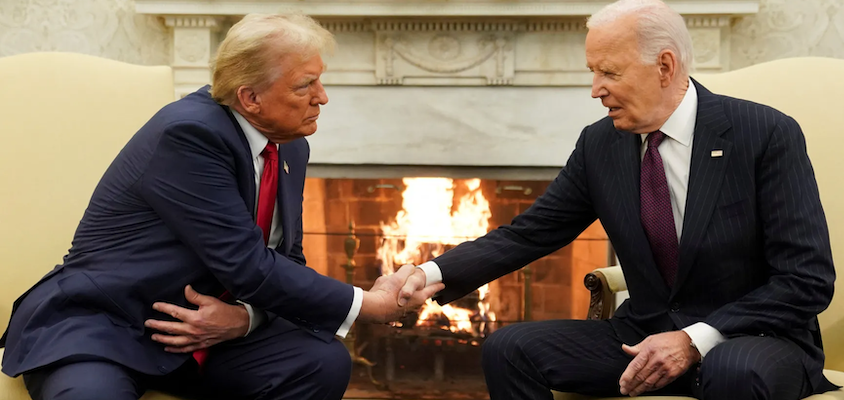EDITORS, BLACK AGENDA REPORT

Manning Marable reminds us that US fascism is institutional and normalized. The parallels of his 1981 essay with the present are obvious – US fascism remains ascendant.
What is an anatomy of American fascism? The late African-American historian Manning Marable asked this question in a two-part article titled, “The Prospects for Fascism,” published in 1981 in the New Journal and Guide, the longstanding Black newspaper from Norfolk, Virginia. Writing at the beginning of the Ronald Reagan era, Marable suggests a genealogy of US fascism that began with Lyndon B. Jonson’s escalation of the “genocidal war” in Vietnam, continued through the vicious “peanut-brained schemes and dreams” of Jimmy Carter, and appeared to be on the verge of an explosion with the rise of Reagan and the New Right in the early 1980s.
Marable’s genealogy is important. He does not argue fascism appears fully formed in the satanic presence of Ronald Reagan, but that the structural and institutional basis of US fascism had existed long before Reagan’s election, giving Reagan a platform for fascism’s intensification and expansion. Marable also argues for the exceptional nature of US fascism – an exceptionalism based on normalization. That is, US fascism does not occur through coup d’etats and the spectacle of regime change but through so-called democratic institutions. For Marable, two other characteristics are significant. First, the intensification of racism and the mainstreaming of white supremacy. Second, the consolidation of corporate power and the attack on labor and the working classes as a response to declining rates of corporate profit.
The parallels with the present are obvious; the historical continuity with the past is apparent; US fascism remains ascendant. Without further comment, we reprint Manning Marable’s “The Prospects for Fascism” below.
The prospects for fascism
by MANNING MARABLE
The victories of the New Right in the election of 1980, combined with the revival of the Cold War abroad and racial prejudice at home, represent a new phase of American politics.
There is growing concern among the world’s progressive and Third World countries, and among the oppressed peoples of this nation, that there is something seriously wrong in the United States. A mood of racial bigotry and social intolerance which generated the neoconservative political thirst in the 1970s is maturing into an ominous and starling political movement for white power. Without exaggeration, many critics of the political scene are describing the new mood in one simple yet devastating word, fascism.
Many of us told ourselves that fascism was just around the corner during the 1960s. We saw the Johnson Administration’s genocidal war in Southeast Asia, and we denounced it as fascist. We learned about “Tricky Dick” Nixon’s Watergate burglaries, his illegal war into Cambodia, and the development of the COINTELPRO to destroy the black movement, and we declared that he was fascist. We read about Gerald Ford’s stumbling, bumbling pardon of Nixon, his cutbacks in affirmative action programs and environmental controls, and some of us called him a fascist. We endured four years of peanut-brained schemes and dreams, the revival of the Cold War, and the murder of hundreds of black women, men and children in the streets of this nation, under James Earl Carter. Some of us called him fascist. The term fascist was used so often that many people no longer listened. As in the fable of the boy who cried “wolf!”, many working and poor people were ill prepared when the real thing began to materialize.
What we must understand is that American facism will not look like anything the world has seen to date. Under a fascist regime, no wall portraits of the criminal Adolf Hitler will be in view. Mussolini and Juan Peron will not re-emerge. In fact, the formal institutions of U. S. democracy, the Congress, the Presidency and the Supreme Court, may still exist, although radically transformed. Elections will still occur, commercial television and the media will be broadcasting the same old garbage; the rhetoric of New Right will be trumpeted from the heights of governmental power and within cultural institutions, but the “appearance” of normalcy will still prevail.
Fascism is not necessarily a coup d’etat, or the overthrow of a formally elected government by the armed forces, as in Chile in 1973. Under U.S. fascism, in all probability, not a single soldier will leave the barracks.
Fascism, then, must be understood in the U.S. as a covert, rather than overt, transferral of authority into the hands of a very small fraction of racist and capitalist elites. It is the final, desperate attempt of those social forces to maintain their control over the economic and social order, at the expense of constitutional democracy.
What is an anatomy of American fascism? What are the critical variables that may comprise the nexus of white power and economic dictatorship in this country?
Black Agenda Report for more
